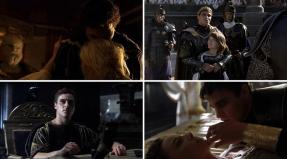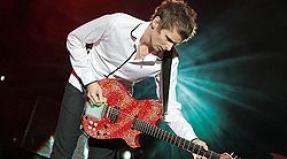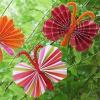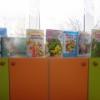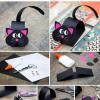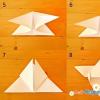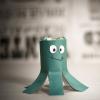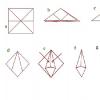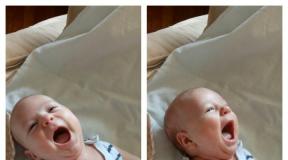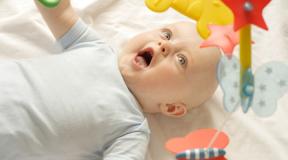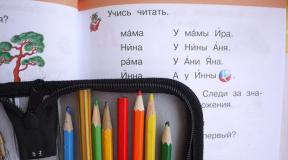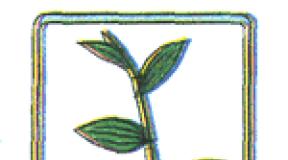Receptions of TRIZ technology in the classroom on etiquette. Application of methods and techniques TRIZ in the classroom in children's creative associations methodological development on the topic. Video: an open class in the middle group on social and emotional development with elements of technology
The minds of babies are free from stereotypes and patterns, they are truly active and open to cognition of the vast world around them. The non-standard perception of the world allows children to have charming spontaneity and purity, delightful ingenuity, the ability to be surprised and notice what sometimes serious adults cannot see. No wonder they say that the mouth of a baby speaks the truth. Over the past decades, one of the most popular methods in kindergartens has been a version of TRIZ technology (solution theory inventive problems), aimed at unleashing the creative potential of children, which is very important.
Goals and objectives of TRIZ pedagogy in kindergarten
The theory of inventive problem solving (TRIZ) was born in the fifties of the twentieth century thanks to the intellectual efforts of the Russian scientist and science fiction writer Heinrich Saulovich Altshuller, who developed this concept on the basis of the thesis "creativity in everything" - in the formulation of the question, presentation of material, techniques and methods of work. He relied on the statement of L. S. Vygotsky that the child perceives the programmatic moments of learning to the extent that they correspond to the nature of his "I", that is, the teacher must work in accordance with the principle of being different from nature. TRIZ methods and techniques have universal properties, have different levels of complexity, they are used in kindergarten from the age of three.
Each child is initially talented and even brilliant, but he must be taught to navigate modern worldin order to achieve the maximum effect at a minimum cost.
G. S. Altshuller
Heinrich Saulovich Altshuller was an outstanding scientist who was distinguished by kindness and foresight
The strategic goal of TRIZ pedagogy is comprehensive development creativity child. Tasks of using TRIZ technology:
- development of non-standard, systemic, relaxed, large-format, flexible thinking, the ability to track subtle cause-and-effect relationships, see the logical patterns of occurring phenomena and events;
- formation of a holistic picture of the world;
- fostering interest in search activity, the desire to develop unusual options for solving the problem;
- development of speech, memory, creative imagination.
The strategic goal of TRIZ-pedagogy is the development of the child's creative potential
The fundamental difference between TRIZ and the generally accepted traditional methods of teaching and upbringing is the desire to form the heuristic skill of independently searching for answers to questions, detecting the problem grain of the problem, and not automatically and thoughtlessly reproducing the algorithm proposed by adults.
The algorithm for solving any problems is built in a certain logical sequence of stages:
- Competent formulation of the task, identification of the problem (solving riddles, deciphering metaphors, children independently determine the tasks).
- Revealing and understanding contradictions (good-bad, good-evil).
- Definition of resources (children find out what the object can do, what actions it performs).
- Optimal expected result (expectations based on actual conditions).
- Modeling various solutions, resolving contradictions (exercises, role-playing games, puzzles, rebuses, etc.).
- Unexpected, bold solutions.
TRIZ technology can be an effective tool for the development of analytical and structural thinking
Advantages of using TRIZ elements:
- is a universal toolkit, applicable during compulsory lessons, play activities, regime moments;
- allows you to reveal the individuality of each child;
- stimulates the exchange of original ideas;
- helps to feel the taste of success in achieving your goals;
- stimulates creatively active independent thinking;
- develops children's imagination, which is embodied in play, practical, artistic activity;
- helps to form a personality capable of offering a non-standard solution, find a way out of a difficult situation, help others look at the problem from a different angle.
Video: Five Steps to Creative Thinking (Master Class)
Video: a lesson with TRIZ elements (the world around)
Methods and techniques of TRIZ technology
Let there be as many creative people as possible, the creator will always understand the creator. And the world will change for the better.
L. E. Belousova
Brainstorm
Brainstorming - the most promising from a practical point of view are selected from a large number of expressed solutions and creative ideas. This method can be called a "magic wand", because with its help children can find a way out of difficult situation (how to save the Snow Maiden, how to paint without a brush, how to transfer water in a sieve, etc.).
Organizing and conducting a brainstorming session:
- Preparatory stage:
- a clear and understandable formulation of the problem,
- formation of a team of participants and distribution of roles,
- selection of the presenter's candidacy.
- The main stage. The teacher encourages the creative ardor and enthusiasm of his pupils, does not criticize, does not evaluate, does not limit the expressed thoughts and proposals. Even the most absurd and daring ideas are listened to and accepted for discussion. Main stage content:
- development,
- combination,
- optimization of ideas.
- The final stage:
- critical analysis,
- assessment,
- selection of the most valuable ideas.
During a brainstorming session, the most promising ideas are selected from a large number of proposed solutions
Examples of discussion questions:
- how to prevent the bear from destroying the teremok;
- how to perform a melody without musical instruments;
- how to tell a fairy tale without words;
- how to draw without paints;
- where to find summer in winter;
- how not to stain the floor with dirty boot soles.
Synectics
The method was formally proposed by William Gordon in the early sixties. The purpose of the method is to introduce the unfamiliar, to move away from the familiar. According to the author, analogies will help develop the child's creativity:

Developed in the thirties of the twentieth century by a professor at the University of Berlin E. Kunze, it is used in the development of creative writing skills, when children compose a new, often unpredictable, fairy tale plot from random words chosen at random from a book that denote characters, objects, actions, etc.
The catalog method promotes the development of children's imagination
Focal Object Method
It is a logical continuation of the catalog method. The method contributes to overcoming the inertia of thinking, the development of imagination, since the children are tasked with transferring the properties of one object to another, which, of course, breaks the stereotypes of perception. Object cards are used for games, children name the characteristic features of these objects, then transfer them to other objects.
- Game "Surprise" (senior group). The material is cards depicting various objects (an elegant dress, a children's toy car, a bright ball, a balloon, a doll, a book, etc.). Two participants choose cards and name the features of the depicted objects, for example, "a beautiful, high-speed car with automatic control" or "an interesting, large book with fairy tales." Then the teacher invites the children to "exchange" properties and re-tell about their subjects, but with new signs: “I have a beautiful book with automatic control, which itself tells fairy tales. And I have a big car for fairy tale characters. "
- The game "Inventors" (middle group) invites kids to design pieces of furniture, technical devices, unusual buildings, to come up with a nonexistent fantastic animal, for example, "Bunny" - was born in the family of a hare and a monkey, lives in the forest, runs fast, deftly climbs trees, jumping from branch to branch, loves sweet fruits and juicy vegetables.
System analysis (system operator)
The method helps to form a holistic picture of the world, develops "multi-screen" thinking, as it teaches to see the interaction of objects in unity and opposition, to be aware of the movement of time, as well as to understand and evaluate the role and place of each object. System analysis value:
- Helps to understand what parts (subsystem) consists of and an element of what whole (supersystem) the object (system) is; introduces the actions and functional properties of individual parts, allows you to understand in which subsystems and systems these parts are combined, which vertical (from bottom to top) form.
System operator. Object - fox cub
- Promotes the formation of the ability to analyze the actions of an object, taking into account the time scale (past, present, future) at the level of the system, subsystem and subsystem.
System object (timeline). Object - bow
- System: hare.
- Subsystem: eyes, nose, long ears, soft paws, fluffy tail.
- Supersystem: forest animals.
- The past: before the hare was a little hare, the mother hare took care of him, she fed him milk, taught him how to get food, hide from predatory animals.
- Present: now the hare is an adult, he is handsome, strong, agile and fluffy.
- Future: the hare will grow up, turn into an old, wise hare who will take care of his grandchildren.
- Antisystem: the hare is afraid of the wolf, therefore, the wolf hunts the hare and can eat it.
In work with older preschoolers, an extended, nine-screen version of the "Magic Screen" technique is used; for younger preschoolers, three or five elements are used, located in a horizontal or vertical row. In a similar way, you can build an interesting informative conversation during games and walks, for example, about why it is raining, snowflakes are falling, a rainbow appears, birds and butterflies fly, trees and flowers grow, etc.
How to master systems analysis: Lull's rings
Lull's rings help to master system thinking - an effective multifunctional game tool that is used in all types of educational activities (mathematics, speech development, musical education, literacy training) and consists of three rotating circular zones:
- small circle - cards with the image of objects participating in a plot-role-playing game (fairy-tale heroes, a person, an animal, an object, etc.);
- middle circle - attributes for the game (magic wand, steering wheel, syringe, hole, nest, etc.);
- large circle - actions of objects (saves the princess, rides, heals, runs, etc.).
Llull's rings are an effective multifunctional play tool that is used in all types of educational activities
- Game "Fairy tale in a new way". Two rings are untwisted, then the child models a story using a randomly dropped combination of two cards (a fairy-tale hero and an attribute of a fairy tale). It is necessary to compose the plot of a fairy tale, considering, for example, such unusual couples as Cinderella and the Golden Key, Buratino and boots-runners, Cheburashka and a flying carpet, etc.
- Game "Who's whose baby". Circles with the image of animals and cubs. A paradoxical situation is discussed, for example: "How will hares raise a wolf cub, and a chicken a fox?"
Video: Llull's rings
Morphological analysis
Morphological analysis is a combinatorial method, the essence of which involves the birth of a new original creative solution or image by a systematic enumeration of all theoretically possible options solutions or characteristics of the object. The morphological table consists of two coordinate axes - horizontal (object) and vertical (signs). The morphological box includes a larger number of axial lines, for example, there can be several objects (child, teenager, old man), the list of characteristics expands (clothing, mode of movement, appearance, character).
Example: an arbitrary choice of characteristics gives very interesting new images, for example, Carlson is a cute, obedient child, dressed in a festive costume, living in an enchanted castle and moving on roller skates. Such a fun game opens up new opportunities for children's artistic experimentation and the development of imagination.
The morphological table consists of two coordinate axes - horizontal (flower) and vertical (color, shape, quantity, shape)
Danetka
Rather a game than a method, Danetka teaches you to formulate questions accurately and clearly, highlight the most significant signs, and systematize objects according to general characteristics.
Rules: children guess the object with the help of leading questions, which they themselves formulate, you can only answer "yes" or "no". Initially, questions of a general nature are raised (this is a person, an animal, a mechanism, a plant, etc.), then more directed and clarifying.
Danetka is a method that teaches you to accurately and clearly formulate questions, find the most important signs, systematize objects according to general characteristics
"Gold fish"
The method teaches to distinguish between the real and the fantastic, to see the interpenetration and intertwining of these two worlds. Analysis of a fairy tale from the point of view of separating real and fantastic events:
- the old man threw the net and pulled out a fish - a real situation;
- caught a talking Goldfish - unrealistic, since aquarium fish do not live in the sea.
Hypothesis: an aquarium crashed on the deck of a ship sailing around the world, and the goldfish got into the sea. Thus, the hypothesis helps to step over from a fabulous, fantastic situation into a real one.
Typical methods of fantasizing - six faithful friends-wizards help the child to get comfortable in the world of fantasy, who can turn an adult into a kid, transform a stone into a human or an animal, go on a journey in a time machine, join the fragments of a broken vase.
Modeling by little people develops an understanding of the essence of natural phenomena, the composition of matter. Fairy tale characters behave differently in different substances, for example, in solid bodies they are inseparable, motionless and firmly pressed against each other, in liquid bodies they are next to each other, but not so close, and finally, in gaseous bodies, they are very playful and constantly move. Therefore, through experimentation, children come to the conclusion that when water turns into ice, people change their character and behavior.
Modeling by little people is valuable for its simplicity and clarity
TRIZ technology classes in kindergarten
Each teacher is interested in making sure that the children in the lesson are not bored, and they carry out the tasks as consciously as possible, while showing independence and creativity.
Types of occupation:

TRIZ-lesson plan
A TRIZ lesson is held in the same time frame (15 minutes - junior group, 20 minutes - middle group, 25-30 minutes - senior and preparatory), as the traditional one and in a similar structure, but the filling of the stages differs in specific tasks and exercises corresponding to the logic of solving inventive problems.
- Stage one (introductory, motivating) - awakening interest, identifying a problem, setting a problem, formulating a topic for a lesson. Instrumentation: morphological analysis, synectics (clues in the form of metaphors, riddles, elements of theatrical performance).
- Stage two (main) - clarification of contradictions, clarification of the resource base with the help of games, modeling of possible solutions using the methods of TRIZ.
- Stage three (reflection) - choosing the optimal solution, self-esteem and introspection (What did you do? What did you learn? What worked and what didn't?), Tracking the logical chain of reasoning. Toolkit: introduction to the operation of the system operator element, the use of morphological analysis.
Table: summary of the lesson in the preparatory group "Visiting the Fairy Tale", author Natalia Olegovna Paraunina
| The purpose and objectives of the lesson | Objective: To continue teaching children creative storytelling using TRIZ technology. Educational tasks:
|
| First stage (introductory) | The chairs stand in a semicircle near the board. Each chair has a landmark (flower). Children go to the music "Visiting a Fairy Tale", get up near the teacher. Q: “There are many fairy tales in the world Sad and funny But live in the world We cannot live without them. Everything can happen in a fairy tale Our tale is ahead. We will knock on the door of a fairy tale Fairy tale, wait for us on a visit. Q: Today we are going to visit fairy tales. “If you name a fairy tale, You will take the flower with you. " Q: What is your favorite fairy tale? Children call, the teacher hangs a "flower" on each child's neck - reference point. Q: These are unusual flowers - they will help you travel through fairy tales. "All the flowers swayed We found ourselves in the land of fairy tales ”. Children sit on chairs, each has its own reference point on the back. |
| Second stage (main) | Q: Children, the magician put on "invisible hats" for fairy-tale heroes, so now we will only hear their voices. Listen carefully and call quickly. An audio recording sounds. Children name characters. Voice: Brother - Ivanushka, Mashenka, Zolotaya Rybka, Carlson, Princess - frog. Winnie the Pooh, Mom Goat, Fox, Emelya, Morozko, Ivan the Fool. Q: Well done! You recognized all the heroes, but the wizard continues to perform tricks. On the blackboard is a poster "Fairy Tangle". Q: See what he did? D: He mixed up all the tales. Q: And what tales did he mix up? Name them. D: "Puss in Boots", "Cinderella", "Little Red Riding Hood", "Masha and the Bear", "The Frog Princess", "The Princess and the Pea", "By the Pike's Command", "Zayushkina's Hut", "Hare is a boast ". Q: Right. And what did the magician confuse in the picture? D: Cinderella is given to try on a crystal slipper, not boots. It is not the puss in boots that tries on the shoe, but the prince. The bear is not carrying the Frog Princess, but Mashenka. The princess on the Gorshin sleeps not on the stove, but on the feather bed, but on the stove from the fairy tale "By the Pike." Little Red Riding Hood meets not a hare, but a wolf. (The teacher removes the poster from the board). Q: “We all have solved the fairy tales And they found all the heroes. We need to go further. " (Children stand up one after another and follow the teacher). Q: "We will go along the path Let's cross the bridge. " ("Bridge" - two arcs. Children pass between them). Q: Anyone who calls the word the other way around will go across the bridge. Flowers will help you find your place. - Merry - sad, - kind angry, - Brave - cowardly, -Old - young, -Strong - weak, -Healthy - sick, -Smart - stupid, - Polite - rude, - Well-fed - hungry, - Mighty is weak, - Mischievous - obedient, - Lazy - hardworking. The "bridge" is removed. To the left of the window is an easel. Flowers on the floor - landmarks. Children stand up, each one, near their reference point. On the easel there are “shadows” of fairy-tale characters. Q: The wizard hid the heroes. If we solve them, we will rid them of the magic. " Q: We name the shadow, turn it over, whether we guessed correctly. D: This is Baba Yaga, Puss in Boots, King, Emelya, Little Mermaid, Buratino, Serpent Gorynych. (As they are named, the children turn over the illustrations, there is a color image). Q: You have recognized all the heroes, now we will rest. Exercise for the eyes. We came to a wonderful forest. (Eyes drew a circle to the right). There are many fairy tales and miracles in it. (Circle left) On the left are pines - on the right are spruce, (With eyes to the right and left) Above is a woodpecker, fat and fat. (Eyes up and down) Open your eyes, close. And hurry home. Q: Go to the window. Look at the circle on the window, look at the house. How many windows on the ground floor are light on? Count. Look at the circle. On the top floor? Q: Well done! Back to our chairs Q: While we were traveling, the wizard came here again and left us portraits, but unusual, portraits - lines. Q: What line is it? (The teacher shows a wavy line on the board). D: It's a wavy line. Q: What kind of character should a hero have, who can be portrayed with such a line? D: He must be kind, gentle, affectionate, hardworking, caring Q: List the heroes of fairy tales with such a character. D: Cinderella, Snow White, Swan Princess, Mashenka, Vasilisa the Wise, Elena the Beautiful. Q: Right, but why? D: They are all kind, generous, caring, affectionate, gentle. (The teacher hangs a portrait of Cinderella on the board next to the line). (There is a broken line on the board). Q: Do you think a broken line can be used to draw a kind character? D: No. Q: What does this line look like? D: It looks like lightning, thorns, needles. Q: So, what kind of character can the characters be depicted by this line? D: They are evil, cruel, heartless, envious. Q: List them. D: Kashchei-Immortal, Serpent Gorynych, Baba Yaga, Miracle Yudo. (Together with the line of the character-Snake Gorynych). Q: Right, what is the name of this hero? D: His name is Ivan Tsarevich. Q: What line can you draw it with? D: Can be drawn with a straight line. Q: Why? What is his character? D: He is kind, strong, brave, brave, brave, mighty, wise. Q: List the heroes who have this character. D: Ivan is a peasant son, Ivan is Tsarevich, Prince Guidon, Tsar Saltan, Elisha. (On the board is the character of Ivan Tsarevich and a straight line.) (The teacher hangs out Pinocchio and a line depicting an arc). Q: Why did I put this line next to this hero? What's his name? D: His name is Emelya. Q: What is his character? D: Cheerful, mischievous, funny. Q: Why such a line? What does it look like? D: It looks like a smile. Q: What characters with this character do you know? D: Emelya, Pinocchio, Peter Pan, Carlson. Q: Well done! You told about the heroes correctly. And now you yourself will turn into fairy-tale characters. Music sounds, children get up, leave the chairs, build a circle. Psycho-gymnastics. Q: What is this masquerade? Parade of both animals and birds, You can't figure it out Where is the squirrel, where is the hedgehog. Get ready and watch! A fabulous animal freeze in place. Fairy tales came to visit us. Determine who is who. Buratino and Kashchei, And Malvina and the villain. Get ready and watch! A figure from a fairy tale freeze in place. (Children go to their chairs). Q: And now we will compose our own fairy tale. "Let's play with a cube, We will compose a fairy tale. " (On the easel there is a plan of fairy tales). Q: The first step is to roll the dice, count how many fell out, look for a diagram, this is the beginning of the tale. We make an offer. We throw the dice again - we count, we make the second sentence according to the dropped scheme. Just five steps. Our tale should be interesting, complete, a miracle, magic should happen in it. It should contain fairy-tale heroes and good to defeat evil. (Children compose a fairy tale according to the fallen out schemes, the teacher guides, asks questions). |
| Stage three (reflection) | Q: Well done! So it's time for us to return. Did you enjoy visiting fairy tales? D: Yes. Q: What did you like? What do you remember the most? (Children answer) Q: Believing in a fairy tale is happiness, And to the one who believes A fairy tale will definitely open all doors. " The teacher distributes medals - souvenirs. |
Table: examples of topics for training in the TRIZ methodology
| "Tips for a cheerful Kolobok" (middle group) | Complex lesson on the development of imagination. Purpose: development of children's creative imagination in speech and visual activities based on TRIZ elements. Equipment:
|
| "A journey through fairy tales" (older group) | Purpose: To consolidate children's knowledge of fairy tales and their names. Tasks:
Materials and equipment:
|
| "The world around us" (senior group) | Tasks:
Equipment:
Vocabulary work: highlighting the first sound in a word. |
| "Save the princess" | Lesson on the development of speech and familiarization with the literature. Objectives:
Material:
|
| "Seasons" (preparatory group) | Purpose. To develop the creative and musical abilities of children in the process of consolidating knowledge about natural phenomena at different times of the year. Tasks:
Equipment:
Musical repertoire:
|
| "How the chanterelle hid the rabbits" (middle group) | Complex lesson. Objectives:
Material:
|
| "Chest with riddles" (middle group) | Classes on acquaintance with the surrounding world. Software content:
Materials and equipment:
|
| "Ant story" (senior group) | Cognitive development. Tasks:
Subject-spatial developmental environment:
|
| "Listen with all your ears" (middle group) | Integration of play activities in the cognitive and experimental development of preschoolers. Purpose: familiarization with the types and functions of the ear, its structure. Tasks:
Dictionary activation:
Material:
|
| "Visiting the Princess Droplets" (middle group) | Purpose: to show children the importance of water in human life. Tasks:
Material for the lesson:
Preliminary work:
Subsequent work: inventing and drawing a magic fish using the Wonderful Things game (method of focal objects). |
Table: card index of TRIZ games
| What can he do? (game for children from 3 years old) | Purpose: formation of the ability to identify the functions of an object Game rules: The host names the object. (The object can be shown or guessed using a Yes-No game or a riddle). Children must determine what the object can do or what is done with its help. Game progress: Educator: TV. Children: Can break down, can show different films, cartoons, songs, can collect dust, turn on, turn off. Q: What can a ball do? D: Jump, roll, swim, deflate, get lost, burst, bounce, get dirty, lie down. Q: Let's dream up. Our ball got into the fairy tale "Kolobok". How can he help Kolobok? Note: You can move the object to fantastic, unrealistic situations and see what additional functions the object has. The basis of personal culture. Q: A polite person is what kind and what can he do? D: Greet, politely see off guests, take care of a sick person or dog, he can give up his seat on a bus or tram to an old woman, and also carry a bag. Q: More? D: Help another person out of trouble or a difficult situation. Q: What can a plant do? D: Grow, drink water, blossom, close, can sway from the wind, can die, it can smell delicious, or it can taste bad, can inject. Q: What can an elephant do? D: An elephant can walk, breathe, grow. The elephant gets its own food, transports goods, people, performs in the circus. He helps people in the household: he even carries logs. Q: What can rain? D: Dissolve the ice. |
| Sooner-later (from 3 years of age) | Purpose: to teach children to make a logical chain of actions, to consolidate the concepts of "today", "tomorrow", "yesterday" ... to develop speech, memory. Rules of the game: The presenter names a situation, and the children say what happened before, or what will happen after. Can be accompanied by a show (simulation of the action). For clarity, you can use the time axis, where you will see a step-by-step sequence of events forward or backward. Game progress: Q: We are now with you for a walk. What happened before we went out for a walk? D: We got dressed for the walk. Q: And before that? D: Before getting dressed, we folded toys, and before that we played builders, and even earlier we had breakfast ... Q: We came from a walk. What will happen next? D: We will undress, wash our hands, the attendants will set the tables .... Q: I made a dress. What did I do before? Show me! D: You went to the store, bought fabric (the child silently shows with actions), took scissors, cut the fabric…. When consolidating the concepts of "today", "tomorrow", "yesterday" ... Q: What day of the week is it today? D: Tuesday. Q: What day of the week was yesterday? D: Monday. Q: What day of the week will it be tomorrow? And the day after tomorrow? ... |
| Locomotive (from 3 years of age) | Purpose: to teach to build logical chains, to develop attention, memory, thinking. Rules of the game: The presenter prepares 5-6 versions of the image of one object in different time periods: a tree or a bird, or a flower, a person, and so on (objects of a living system). Cards with the image of one object are handed out to the players. Game progress: The presenter is a teacher, and later a child train, and the rest of the children are trailers. A "time train" is being built. Q: Let's take the human time train. On the table there are random images of a baby, a little girl and a boy, a schoolboy, a teenager, an adult, an elderly person. Each child chooses a picture he likes. The presenter takes his own, gets up, and the child stands behind him with the next picture in meaning, and so on. (When familiarizing with the concepts of "system now", "system in the past", "system in the future"). (When expanding the understanding of the growth and development of representatives of the animal world, when observing the inhabitants of a corner of nature, as well as getting acquainted with the seasons). Q: Here is a picture of a green leaf. (Pictures of a leaf were selected in advance at different time intervals: a yellow leaf, a fallen leaf, a leaf under the snow, a small leaf with a light green color, and so on). Children choose pictures and line up in a little train. Q: What time of year is it? D: Winter. Q: What happens in winter? D: It's snowing, frost. Q: Is it okay? D: You can go sledging. Q: Why is sledging bad? D: You can fall and hit. Q: I am putting on the first trailer of the time train. In the picture it is snowing, people are skating. What season will be next? Children choose pictures. Note: For older children preschool age you can build a more complex "time train". An object is taken from an inanimate system: a car - as a mode of transport or as a means of transporting cargo. |
| Where does he live? (from 3 years old) | Purpose: to identify suprasystemic connections, to develop speech, thinking. Rules of the game: The presenter names the objects of the surrounding world. In the younger preschool age, these are inanimate objects from the immediate environment and objects of wildlife. In the senior preschool age, these are any objects and phenomena of the real and fantastic worlds (where a smile, fire lives). Children name the habitat of living objects and the location of real and fantastic objects. Game progress: Q: Look how many pictures there are! Choose any for yourself! At an older age, objects can be guessed by the children themselves in advance, or the presenter names each object from himself. If the educator has a clear goal: to consolidate, for example, the section "Living and inanimate systems", then the main set of pictures should consist of objects of a living and inanimate system, and so on. Q: Where does the bear live? D: In the forest, at the zoo. Q: What else? D: In cartoons, in candy wrappers. Q: Where does the dog live? D: In the kennel, if she guards the house. In the house, right in the apartment. And there are dogs living on the street - stray. Q: Where does the plantain live? D: It grows on the track. On the lawn and in the field. And also in the pharmacy. And when I applied to the wound, it lived on my leg. And I drank it, so it was in my tummy. Q: Where does the nail live? D: In the table, in the factory, in my dad's garage. In the toolbox. On the wall. In a chair. In my shoe! |
| What will happen if ... (from 3 years old) | Purpose: to develop thinking, speech, flexibility of mind, imagination, acquaint with the properties of objects, the surrounding world. Rules of the game. This game is based on questions and answers. “What will happen if a paper, stone, beetle falls into a bath with water?”, “What will happen if it snows in the summer?” Questions can be different - both everyday and "fantasy", for example: "What will happen if you find yourself on Mars?" Game progress: The teacher asks the child a question "What will happen if paper falls into the bathtub with water." The child answers the paper will get wet, melt, float, etc. |
| The sun is shining (from 3 years old) | Purpose: to develop thinking, speech, speech, flexibility of mind, imagination. Rules of the game: You start a sentence and the child finishes. For example, it rains, and yet ... the sun is shining ... the dog is barking ... the locomotive is racing ... Game progress: You can combine two objects or living beings and name the common actions for them. Snow and ice are melting, the bird and the plane are flying, the bunny and the frog are jumping. Or one action and many objects: a fish, a boat, a ship, an iceberg is floating ... What else? The sun warms, a fur coat, a battery ... And what else? The car is humming, the train ... |
| Good - bad (play from early preschool age) | Purpose: To teach children to highlight positive and negative sides in objects and objects of the surrounding world. Rules of the game: Leading is any object or system in older preschool age, a phenomenon in which positive and negative properties are determined. The course of the game. Option 1: D: Because it is sweet. Q: Eating candy is bad. Why? D: Teeth can get sick. That is, questions are asked according to the principle: “something is good - why?”, “Something is bad - why?”. Option 2: Q: Eating candy is good. Why? D: Because it's sweet. Q: Sweet candy is bad. Why? D: Teeth can get sick. Q: Teeth get sick - that's good. Why? D: You will see a doctor in time. What if you had a toothache and you didn't notice. That is, the questions follow a chain. |
| One, two, three ... run to me! (from 3 years of age) | Purpose: to compare systems, to teach to highlight the main feature, to develop attention, thinking. Rules of the game: The presenter distributes pictures of various objects to all the players. Depending on the age, the content of the pictures changes: in the younger groups, these are objects of the immediate environment, animals, and in the older groups, these are objects of more complex content, as well as natural phenomena and objects of inanimate nature. Children can simply think of an object without using a picture. Children get up at the other end of the hall and, according to a certain direction of the teacher, run up to him. In older preschool age, the child may be the leader. The teacher or leader child then analyzes whether the player was mistaken, highlighting any properties of the system. Game progress: "One, two, three, everyone who has wings, run to me!" (Children come running, who have images of an airplane, birds ...) The rest of the children stand still. Further, any components of the subsystem can be selected (eyes, angle, wheels, smell, sound ...). The facilitator asks the players where their objects have these parts. Note: You can use tasks for the supersystem. For example: "One, two, three, everyone who lives in the field, run to me!" Children run up to the presenter with an image or mysterious objects of cabbage, stone, sand, earth, mouse, grass, wind, tractor. The facilitator asks when the tractor can be in the field (during sowing or harvesting). You can use assignments for the object function. For example: "One, two, three, those who can sing run to me!" Children run up to the presenter with the image of a bird, man, wind, radio ... An interesting use of assignments for time dependence. For example: "One, two, three, everyone who was small before, run to me!" Children with the image of a man, bird, flower, wind run up to the presenter ... Children with the image of a tractor, earth, sand do not run up ... When forming an idea of \u200b\u200bsome plants: “One, two, three, everyone who has leaves (trunks, stems, roots, flowers) - run to me. When forming ideas about animals (eyes, hair, long fluffy tail, hooves, horns ...). |
| Reducing and increasing (from 3 years old) | Purpose of the game: to enrich the vocabulary of children, to teach to educate with the help of suffixes: - ok, - chick, - check, -ishche. Rules of the game. Say, "I will name someone or something, and you make it small." For example, a mushroom is a fungus, a chair is a chair, a leaf is a leaf. Make sure that the child does not name the cubs instead of the correct answer: not a hare - a hare, but a hare - a bunny; not a cow is a calf, but a cow is a cow. The same can be done in the opposite direction. The adult names the "reduced" word, and the child gives it the usual version. The same games can be carried out with "increasing" suffixes: cat - cat, lesson - tract. |
| Name, in one word (from 3 years old) | Purpose: to enrich the vocabulary of children with nouns, to develop speech, attention, thinking. Rules of the game. An adult describes something, and a child calls it in one word. For example, the morning meal is breakfast; a large dish for making compote - a saucepan; tree that is dressed up on New Year, - Christmas tree. |
| Chain (from 3 years old) | Purpose: to teach children to highlight the signs of objects, to develop thinking, speech of children. Rules of the game: The presenter shows the child a picture of the object, he names it. The picture is then passed on to another child. He must name one of the attributes of the object and transfer the picture to the next. You need to name as many signs as possible and not repeat. Game progress: The presenter shows a picture with the picture of glasses, the child, seeing the picture, says round glasses and passes the picture to the next player. The next player says sunglasses and passes the picture to the next player, etc. |
| What was - what became (from the age of 4) | Purpose: to determine the line of development of the object, to develop logical thinking, speech. Rules of the game: 1st option: The leader names the material (clay, wood, fabric ...), and the children name the objects of the material world in which these materials are present ... 2nd option: The presenter names the object of the man-made world, and the children determine what materials were used in its manufacture. Game progress: Q: Glass. It used to be an alloy of different materials. D: Glassware, windows, mirror are made of glass. There is glass on the TV screen, glass showcases in the store. And I saw a glass table. My mom has glass beads. Q: What's good about a glass table? D: It's beautiful, you can see a cat lying under the table. Q: What's wrong with such a table? D: Such a table can break and people will be cut by fragments ... Q: What else can be made of glass? D: There are glasses in glasses, there are glass chandeliers, and there are glass bulbs in them, the clock also has glass. Q: Have you heard the expression: "He has a glass heart." About whom can I say that? D: So you can say about an evil, "prickly" person. Baba Yaga has an evil heart, she has it made of sharp fragments. Q: What are the fairy tales in which there are heroes with a glass heart! The teacher summarizes the children's answers. |
| Magic traffic light (from 4 years of age) | Purpose: To teach children to highlight the system, subsystem and supersystem of the object, to develop logical thinking, attention, speech. Rules of the game: At the “Magic Traffic Light”, red means a subsystem of an object, yellow means a system, green means a supersystem. Thus, any object is considered. The object in question can hang (lie) in front of the child, or it can be removed after being shown. Game progress: The teacher hangs out a subject picture of the car (in the older preschool age - a diagram of the car). Q: If I pick up a red circle, you tell me what the car consists of. If I lift the circle green color - tell me what the car is a part of. And if I raise a yellow circle, then you tell me: what is it for; draw this object in the air, depict this object (in the senior and preparatory groups - using the empathy method). This game can be used when viewing a picture. Q: If I raise the circle in red, you will name the objects that you see in the picture. If I show you a yellow circle, you can tell me what this painting can be called. And if I raise the green circle, determine what the subject of the picture is a part of (the natural world, transport, pets). Living and non-living systems. Q: Cactus. (picks up a green circle). D: Cactus belongs to the natural world, to a living system, to plants. He can live in a room on the windowsill, and he also lives in the desert. The teacher (in the senior and preparatory groups - the child) raises the red circle. D: A cactus has roots, thorns, flowers in adult cacti. Q: Why do cactus have thorns? D: In order not to be ripped off, he is so protected. The teacher raises a yellow circle. D: A cactus is needed for beauty (especially when it blooms), a cactus provides oxygen, and people breathe oxygen, and a cactus is also food for animals in the desert. The teacher or leader - the child asks to turn into cacti: into a blooming cactus, into a cactus that was watered a lot, a cactus in a cramped pot, a cactus in the desert ... |
| Box with fairy tales | Purpose: to develop speech, thinking, imagination, enrich the vocabulary of children. You will need a box with 8-10 (pictures). Rules of the game. The teacher offers to take the figures out of the box at random. We need to figure out who or what this object will be in the fairy tale. After the first player has said 2–3 sentences, the next one takes out another object and continues the story. When the story is over, the items are put together and a new story begins. It is important that each time you get a complete story, and that the child in different situations come up with different options for actions with the same object. |
| Confusion (from 4 years old) | Purpose: to consolidate the ability of children to find the typical properties of an object. Course of the game: The teacher names 3-4 objects with unusual properties (for example, a pointed tiger, a striped pencil, a frozen shelf, book glass) and asks the children to restore order, that is, to choose a typical property for each object. |
| We save Kolobok (from 4 years old) | Purpose: to develop creative imagination, to teach fantasy to endow famous fairy-tale characters with qualities that are not inherent in them. Develop unconventional thinking. Equipment: book "Kolobok" table theater "Kolobok". TRIZ tool: "Good-bad" game (identification of negative and positive properties, resolution of contradictions). Game progress: - Children, look carefully, who can tell what this book is called? That's right, "Kolobok". I will open the book, and you call Kolobok, maybe he will come to us. Children call, Kolobok appears (table theater). - Kolobok, why are you so sad? Guys, he is sad because he forgot who he met in his fairy tale, what characters. Let's help him. Children list the heroes of the fairy tale, retell its content. - The fox really wanted to eat Kolobok. Is this good or bad? - What's good (the fox is full)? - What is bad (Kolobok was eaten)? - What can be done to prevent Lisa from getting Kolobok, how to save? (feed before meeting Kolobok)? What kind of Kolobok should become so that the Fox does not want to eat it (inedible, dirty, stale, poisonous)? |
| Guess the secret (from 4 years old) | Purpose: to teach children to hypothesize. Course of the game: The teacher suggests the phrase: object + unusual sign (for example, a furry book). Asks children to make suggestions, from which object this sign could be taken - hairiness. The children's answers are in a bear, a dog, etc. |
Video: games based on TRIZ technology
Development of speech using TRIZ technology
TRIZ can be widely used for the development of speech skills in pupils.
Main steps
Development of expressiveness of speech by creating figurative characteristics of the object:
- Stage one (from the age of three) - making comparisons in color, shape, action (red fox, the same as Antoshka in a children's song).
- Stage two (4–5 years) - composing your own riddles in accordance with the developed models in the form of tablets with questions. For example, the proposed object is the sun. Children consistently answer questions, the teacher fills out the table, entering characteristics (color, shape, action): which one? - yellow, round, warming; what happens the same? - chicken, ball, stove. Then the children are asked to name the signs of objects: a fluffy chicken, a balloon, a warm stove. After filling out the table, the teacher asks the children to try to compose the riddle by inserting the ligaments "How" or "But not" between the phrases. The guys work both individually and in cooperation with each other. The final version of the riddle about the sun: “Yellow as a fluffy chicken; round as a balloon, warming, but not a warm stove. "
- Learning to compose metaphors (six to seven years) - it is proposed to master the simplest algorithm for independently inventing a metaphorical phrase. For example, first, an object (stars) is selected, about which a proposal will be made, a property (bright) is determined, then an object with a similar sign (burning embers) is selected, a place (night sky) is indicated, finally a proposal is made (The night sky sparkled brightly with burning coals) ...
Writing poetry
Compilation of rhymed texts - scientists have come to the conclusion that children from the age of three have a natural need for such a word game as versification. TRIZ proposes to use the genre of funny absurdity, a five-line poem, which got its name of the same name from the Irish town of Limerick. An example of a limerick poem:
What would happen if the songbird
Was not as beautiful as a titmouse,
Then she would not run after the beetle,
And didn’t lie on the grass for a long time?
It would be better if she flew in the sky.
In addition, writing rhymed texts can be presented in the form of funny creative games that require a little preliminary preparation from the teacher:
- “Rhymed pictures” - the teacher selects pairs of pictures depicting objects whose names make up a simple rhyme, then shows one of the pictures and asks to choose a steam room.
- "Pick a word" - children learn to pick a rhyme for the proposed word.
- "Teaser" - children modify the words-characteristics with the help of diminutive suffixes and seem to "tease" objects (cap-cover, umbrella-lost, etc.).
Compilation of creative realistic and fantasy stories from the picture
Possible options and techniques:
- games "Spyglass", "Hunters for details", which help to focus the attention of children on the object and highlight all its important details and characteristics;
- “Looking for friends”, “Unions” - aim children at establishing connections between objects;
- selection of metaphors, figurative verbal comparisons, moving an object into the past or future;
- reception of empathy - transformation into a hero, "getting used to" in his emotional state and a story on his behalf, the transfer of character traits with the help of facial expressions and gestures.
Picture storytelling teaches children to fantasize and develops logic
Writing fabulous texts
Retelling and modification of a well-known fairy tale plot. Games and exercises, which are a kind of creative and intellectual warm-up in the preparation of children:
- "Give the name of the hero": the teacher denotes some general characteristic or characteristic, and the children name specific fairy-tale characters. Example: Think of the fairytale heroines of the girls. (Little Red Riding Hood, Cinderella, Malvina, Gerda, Alyonushka, etc.).
- "Actions of a fairy-tale character": the teacher names a fairy-tale hero, for example, Mashenka from the fairy tale "Geese-Swans" and asks to name all the actions of the girl. According to the terms of the game, only verbs can be used (disobeyed, ran, walked, forgot, saved, helped). Then the teacher suggests remembering the heroes of other fairy tales who would perform similar actions.
- "Miracles of the wizard": the game is based on the method of a typical method of fantasy. The teacher invites you to imagine yourself as wizards and tell them what extraordinary property they endowed with ordinary objects, then assess the practical significance of miraculous powers, explain why magic is good, and sometimes evil. Example: a bird in an enchanted forest meets the Wizard of Frost, now everything it touches turns into a block of ice. It's bad if she sits on a tree branch and good if she stops an evil hunter.
- "There, on unknown paths ...": the game is based on the intersection of an object and a place. The teacher works with cards depicting heroes and the place where the plot will unfold. Example: Alyonushka ended up in the Koscheevo kingdom. How will she be saved? Who will help her?
- Fairy tales of the descriptive genre. Fairy tale unfolds in accordance with the traditions of the storyline: the hero grows up, shows unusual abilities and talents, in adulthood he is faced with difficult circumstances, witchcraft wins, and returns his vitality.
- Fairy tales with a pronounced conflict between good and evil, the third active force is a magical object or word, a spell with supernatural powers.
Video: TRIZ technology in speech development classes
Video: dossier on a fairy-tale character (senior group)
Video: the game "Carousel"
Corner decoration using TRIZ technology
A competently designed, accessible and safe corner of TRIZ is a great help to stimulate curiosity, individual cognitive activity, and independence of kids.
In TRIZ-lessons, you can also use didactic manuals designed to familiarize yourself with a particular topic.

Tables and plot pictures contain information that is also useful for educational and methodological tasks.
Open lesson on TRIZ technology
An open lesson must meet certain requirements:
- high scientific and methodological level of TRIZ-teacher professional training;
- educational work with teachers, including methodological master classes and the transfer of innovative experience in the process of the final discussion of an open lesson;
- presentation of the results of the teacher's work within the framework of the topic of self-education in TRIZ methods;
- demonstration of the effectiveness of non-traditional approaches that solve urgent problems of modern preschool education;
- open shows do not require special conditions or preliminary rehearsals, however, it is advisable to psychologically prepare the children for the presence of strangers.
Table: file index of topics for an open lesson
| "Acquaintance with the properties of glass" - a lesson on the development of speech and familiarization with the outside world in the senior group. | Program tasks:
Material: glass objects, bedspread, chips, task diagram. |
| "On the magic path" - a lesson on speech development in middle group. | Software content:
|
| "In the footsteps of a kolobok" - a lesson on sensing in the first junior group | Purpose: Formation of sensory standards and abilities that allow the child to comprehensively perceive the world around him. Tasks:
|
| "Journey to the Forest" - a complex lesson in the preparatory group | Purpose:
Equipment: Toy - dragonfly; two sets of geometric shapes; magnetic board, felt-tip pen, object pictures for the triz game "Traveler's Backpack", "Green Glade"; cards "Guess whose trace", album sheets with Rorschach spots (2 sheets), crayons; Euler's circle "Inhabitants of the Earth". |
| "Lady of Clothes Fashion House" - a complex lesson with TRIZ elements in the senior group | Program tasks:
|
Video: open lesson in the middle group on social and emotional development with elements of TRIZ technology
In life, a person is often faced with situations that test him for the ability to use previously acquired knowledge and skills. And in today's rapidly changing conditions, the formation of the ability for creative thinking and active mental activity, free from psychological inertia and following stereotypes, acquires special relevance. TRIZ pedagogy requires serious preparation from the teacher, a sincere desire to help the child self-actualize and unleash his creative potential in drawing, playing music, solving logical and mathematical problems, working or composing works of art.
Share with your friends! Tatiana Shelofast
TRIZ methods and techniques for improving children's speech
"All the tasks of the speech development of preschool children (enrichment of vocabulary, the formation of the grammatical structure of speech, sound culture) will not achieve their goal if they do not find the final expression in the development of coherent speech" / Ushakova O.S. /
Today - figurative speech rich in synonyms, additions and descriptions in preschool children is a very rare phenomenon. There are many problems in the speech of children:
1. Monosyllabic speech, consisting only of simple sentences. Failure to grammatically construct a common sentence.
2. Poor speech. Insufficient vocabulary.
3. The use of non-literary words and expressions.
4. Poor dialogical speech: inability to formulate a question competently and in an accessible way, build a short or detailed answer.
5. Failure to construct a monologue: for example, a plot or descriptive story on the proposed topic, retelling the text in your own words.
6. Lack of logical justification for their statements and conclusions.
7. Lack of speech culture skills: inability to use intonation, adjust voice volume and speech rate, etc.
8. Bad diction.
It is impossible to judge the beginning of the development of the personality of a preschool child without assessing his speech development. In the mental development of a child, speech is of exceptional importance. The development of speech is associated with the formation of both the personality as a whole and all mental processes. Therefore, determining the directions and conditions for the development of speech in children are among the most important pedagogical tasks. The problem of speech development is one of the most urgent.
Half of preschool children have an insufficiently formed skill of constructing a coherent statement. In addition, most children actively share their impressions of their experiences, but are reluctant to take up stories on a given topic. Basically, this happens not because the child's knowledge on this issue is insufficient, but because he cannot form them into coherent speech utterances.
The task of teachers preschool institutions , according to the Federal State Educational Standard of preschool education - the upbringing of children with high creative potential.
It became apparent that a change in the way they interact with preschoolers was needed to raise talented person, capable of thinking outside the box, looking at the world around him.
One of such technologies can be safely called TRIZ - the theory of inventive problem solving. The founder of this technology is Genrikh Saulovich Altshuller.
The purpose of using TRIZ - technology in kindergarten is development on the one hand of such qualities of thinking as flexibility, mobility, consistency, dialecticism, and on the other hand, search activity, striving for novelty, development of speech and creative imagination.
TRIZ for preschoolers:
This is a system of collective games, activities designed not to change the main program, but to maximize its effectiveness.
It is a “guided process of creating a new one, combining accurate calculation, logic, intuition, ”said the founder of the theory GS Altshuller.
The main tasks of TRIZ education for preschoolers are: the formation of coherent speech based on the activation of creative thinking for productive cognitive, research and inventive activity; development of creative abilities; the formation of the qualities of a creative personality.
Thus, the use of adapted TRIZ methods in the process of speech development in preschoolers contributes to:
Enhancing the cognitive activity of children;
Creation of motivational attitudes for the manifestation of creativity;
Creation of conditions for the development of the figurative side of children's speech (enrichment of the vocabulary of evaluative vocabulary, words with figurative meaning, synonyms and antonyms);
Improving the efficiency of mastering all language means.
The main task of an adult is to create such an emotional environment for decision-making so that children are not afraid to do something wrong in creative tasks. It is also important to clearly draw the line: there are didactic tasks where there is always a correct answer, where the insert must correspond in shape and size to the hole, and the hero must match his fairy tale. And there are creative tasks, where there are fundamentally no correct answers, where there are only different possibilities that each author - both an adult and a child - uses as he wants.
Throughout the preschool age, it is necessary to develop in children the ability to build a dialogue (ask, answer, explain, object, give a reply). To do this, use conversations with children on a variety of topics related to the child's life in the family, kindergarten, with his relationships with friends and adults, his interests and impressions. It is important to develop the ability to listen to the interlocutor, ask questions and answer depending on the context.
TRIZ for preschoolers is a system of collective games and activities. Designed not to change the main program, but to maximize its effectiveness.
The use of TRIZ will lead to the dynamics of the development of speech, inventive ingenuity, creative imagination, dialectical thinking in preschoolers. Children not only develop imagination, they learn to think in a systematic way, with an understanding of the ongoing processes.
Preschool childhood is that special age when a child discovers the world, when significant changes occur in all areas of his psyche (cognitive, emotional, volitional) and which are manifested in different types activities: communicative, cognitive, transformative. This is the age when the ability to creatively solve problems arising in a particular situation of a child's life appears (creativity). Skillful use of techniques and methods of TRIZ (the theory of inventive problem solving) successfully helps to develop inventive ingenuity, creative imagination, and dialectical thinking in preschoolers.
Using the elements of TRIZ in the work on the development of speech with preschoolers, it is important to take into account the following didactic principles:
The principle of freedom of choice - in any teaching or management action, provide the child with the right to choose.
The principle of openness -\u003e it is necessary to provide the child with the opportunity to work with open problems (which do not have the only correct solution). The condition of a creative task must include different solutions.
Principle of operation - practical activity should be included in any creative task.
Feedback principle - the educator can regularly monitor the process of mastering mental operations by children, since there are elements of the previous ones in new creative tasks.
The principle of ideality - creative tasks do not require special equipment and can be part of any activity, which allows you to make the most of the opportunities, knowledge and interests of children.
The main working mechanism of TRIZ is the algorithm for solving inventive problems. Having mastered the algorithm, the solution of any problems proceeds in a planned manner, according to clear logical stages:
1. Communication of necessary knowledge.
2. Formation of skills at the reproductive level:
- demonstration of activities in general and by elements;
- organization of skills training in simplified conditions;
- organization of independent practice with continuous feedback from the child to the teacher.
3. Transition to the search (productive) phase:
- organization of problem situations - solving specific problems;
- mandatory analysis of their activities
When solving TRIZ problems, we use the following tricks:
- graphic analogy - the ability to designate a real image or several images with a symbol, highlighting from them common features;
- empathy - identifying oneself with the considered or identified object, entering the role of someone or something;
- brainstorming - the ability to give a large number of ideas within a given topic and the choice of an original solution to the problem;
- morphological analysis - the ability to give different answers within the framework of two indicators, evaluate ideas and detail the successful ones;
- catalog - the ability to link randomly selected characters and their actions into a single storyline;
- methods of typical fantasizing - the ability to make fantastic transformations of both the object itself, its properties, components, and the place of functioning, habitation with the help of methods given by the teacher;
- method of focal objects (MFO) - selection of atypical properties of an object, their presentation and explanation of the practical purpose of atypical properties.
The main means of working with children is pedagogical search. The teacher should not give ready-made knowledge, reveal the truth to him, he should teach how to find it. If a child asks a question, do not immediately give a ready-made answer. On the contrary, you need to ask him what he thinks about it. Invite him to reason. And by leading questions, lead the child to find the answer himself. If he does not ask the question, then the teacher must indicate the contradiction. Thus, he puts the child in a situation where it is necessary to find an answer, that is, to some extent repeat the historical path of cognition and transformation of an object or phenomenon.
Elements of TRIZ - technologies contain a significant potential, which allows to qualitatively change the process of speech development of preschool children.
Tips for educators when using TRIZ methods:
Resist the urge to lecture and explain a given situation for a long time. If the child does not understand what you want from him, then it is worth postponing this conversation to another time or not returning to him at all. Do not put pressure on the child with words such as "come on soon", "think for yourself", "this is wrong." TRIZ technology in kindergarten means that any opinion and version is worth considering. In addition, the child learns to think gradually, and the teacher's task is to help, not force. Don't forget about praise. Of course, it should be sincere and specific. Let the child feel confident in communication and express his wildest ideas. Rely on the knowledge and concepts that the child is fluent in. To build a chain of hypotheses, you need to have a complete understanding of a given task and situation.
20.03.2017 10:00
The founder of the theory of inventive problem solving (TRIZ) is Genrikh Saulovich Altshuller. Initially, all his developments were aimed at engineering creativity, but later moved on to the field of human activity, going beyond technical: art systems, management, team management, solving commercial, social, socio-technical and pedagogical problems, tasks of the education system.
Adapted TRIZ thinking tools have become widespread in pedagogy, which activate and accelerate the processes of thinking development. This is almost the only systemic theory of teaching creativity in the world.
Parents can try to use certain TRIZ pedagogy techniques in communication with their children from an early age, as soon as they start speaking in phrases. It makes sense to send a child to group TRIZ classes not earlier than 4.5 years old.
Goals and objectives of the methodology
TRIZ-pedagogy aims at the formation of strong thinking and the upbringing of a creative personality, prepared for solving difficult problems in various fields of activity.
Tasks:
The development of a child's natural need for cognition of the surrounding world, inherent in nature.
Formation of systemic dialectical thinking (strong thinking) based on the laws of development.
Formation of skills for independent search and obtaining the necessary information.
Formation of skills to work with information that the child receives from the surrounding reality spontaneously or as a result of purposeful learning.
Education of certain personality traits
Qualities of a creative person
Strong thinking skills
Guided Imagination Parameters
Thinking Algorithms Needed to Successfully Deal with Problems
Developed trainings and techniques aimed at developing thinking skills
TRIZ Usage Models
In practice, there are various models of using TRIZ - tools, which can be episodic and systemic.
The following models can be distinguished
Use in personal practice of individual tools or techniques used in TRIZ pedagogy. For example, a teacher to work with a painting uses the "Picture without hesitation" methodology, and to analyze the meaning of fairy-tale plots - compiling situational danets. All the rest of the material is given according to the traditional method.
Result: children develop those skills that are the result of these techniques. Those. the child will learn to compose stories based on a picture and danets based on a literary plot.
Possible negative: this approach does not always form the skills of strong thinking, but only if the teacher specifically sets himself this task of TRIZ pedagogy.
A special course TRIZ and RTV (development of creative imagination), during the implementation of which children learn the basics of TRIZ as a separate educational discipline (at school - RTV lesson, in kindergarten - RTV lesson).
Result: children learn the terminology and tools of TRIZ and RTV, perform creative tasks of various levels of complexity, solve problems within the framework of this course.
Possible negative: children do not know how to do the transfer or find it difficult to transfer the acquired skills to an everyday or educational situation. That is, being able to solve problems, they do not use this skill in their practice when a need arises.
The use of TRIZ-RTV-tools in the educational process according to the usual curriculum, as a set of effective methods for the implementation of standard content.
Result: the educational tasks inherent in the basic programs are solved with lower costs, the motivation of children increases, the principles of working with certain tools are mastered.
Possible negative: there remains a problem with the skills of personal use of problem solving tools; there is no transfer of the learned skills of working with information to the conscious plane.
Integration of the standard educational program with the program for the formation of creative skills.
Result: the formation of the ZUN system (knowledge, abilities, skills), embedded in the basic programs, is organically combined with the process of forming systemic dialectical thinking and the development of creative imagination. Moreover, ZUN is not broadcast in the traditional sense from the teacher to the children, but is formed as a natural consequence of learning to work with information. The result is complex: TRIZ tools help the teacher to solve didactic problems, and the child - to cognize and transform the world around him.
Possible negative: the option does not work without correcting the content of the basic programs, they have to be rebuilt and adapted to the program for the formation of skills in creative activity and in accordance with the requirements of systems thinking.
It is likely that the fourth model is the most promising and effective, but also the most difficult to implement.
TRIZ methods
The method of brainstorming is the formulation of an inventive problem and finding ways to solve it by enumerating resources, choosing an ideal solution.
Synectics is the so-called method of analogies: comparing and finding the similarity of objects or phenomena. Representation of oneself as an object or phenomenon in a problem situation. Synectic is always paired with brainstorming.
Morphological analysis is the identification of all possible facts for solving a given problem, which could have been missed with a simple search. This method effective in working with a small number of children (from two to five).
The method of focal objects (MFO) is the establishment of associative links with various random objects (properties and characteristics of other objects that are not related to it are "tried on" to a certain object).
Yes - no - ka - finding an essential feature in an object, classification of an object and phenomenon according to common characteristics.
Robinson's method - finding an application for a seemingly completely unnecessary subject.
Typical fantasies are fantasies using specific techniques.
System operator - analysis and description of the system of connections of any object of the material world: its purpose, dynamics of development in a certain period of time, signs and structure, etc.
results
The results of classes are not always possible to visually present to parents, as, for example, when learning to read, count or write. However, empathetic parents will quickly notice changes.
The circle of ideas is enriched in children, vocabulary grows, creative abilities develop.
TRIZ helps to form dialectics and logic, helps to overcome shyness, isolation, shyness; small man learns to defend his point of view, and when in difficult situations to independently find original solutions.
TRIZ contributes to the development of visual-figurative, causal, heuristic thinking; memory, imagination, affects other mental processes.
Children who regularly use such techniques in their work become more active, inquisitive, argue more often, put forward a more detailed and complex argumentation, their imagination becomes richer and more interesting. Such children begin to explore everything around them, which is why TRIZ, in principle, contributes to the formation of a scientific picture of the world. TRIZ classes will do a good job and will certainly be useful in the future in solving life problems.
METHODS AND TECHNIQUES
TRIZ
IN PRIMARY SCHOOL
SEMINAR - PRACTICE
Methodical goal:
To acquaint teachers with TRIZ - pedagogy as a scientific and pedagogical direction, which is based on G. Altshuller's theory of inventive problem solving; with the goals and principles of TRIZ - pedagogy; with a typology of open tasks; with methods for the development of creative imagination (RTV) and the development of creative thinking in children of primary school age; to reveal the concept of psychological inertia; show the practical implementation of a variety of creative tasks.
1. WHAT IS TRIZ?
We are glad to see you at the Invisible Hunters Research Laboratory for Children. Each meeting in our laboratory is held under the motto
"It is reasonable to think,
act, create
for the good of man
yourself and the world
transform".
"To do something differently, you need to be able to see differently."
Most teachers and theorists around the world are convinced of the need to move from "knowledge transfer" to "life teaching". But it must be borne in mind that we must teach children to live in a democratic society. As one of the famous French educators Célestin Freinet wrote:
"Only with the help of freedom can one prepare for freedom, only with the help of cooperation can one prepare for social harmony and joint work, only with the help of democracy can one prepare for democracy."
The school should be the first model of a democratic society, democratic relations. Democracy cannot be taught separately, but only on the condition that such teaching is carried out by each teacher in each lesson through the introduction of appropriate approaches to teaching. One of these approaches - proven, interesting, creative - we bring to your attention. This is TRIZ pedagogy. The goal of TRIZ-pedagogy is the formation of strong thinking and the upbringing of a creative personality, prepared for solving complex problems in various fields of activity.
Methods for solving inventive problems mean techniques and algorithms developed within the framework of TRIZ, as well as foreign methods such as brainstorming, synectics, morphological analysis, the method of focal objects, empathy, and others.
What is TRIZ? Brief historical background.
1946 - work begins on the creation of a scientific technology for creativity, its author is Genrikh Saulovich Altshuller.
1956 - first publication.
1989 - the international TRIZ Association was established. The software product "Inventing Machine" has appeared.
1995-1997 - this software product was acquired by the following companies: Ford, Proctor & Gamble, Motorola, Samsung and others.
For over 10 years, an interesting experience of using TRIZ in education for the development of thinking in children of different ages has been accumulating.
With a teacher who uses theory, children learn with interest, mastering new knowledge effortlessly.
Technologies for the development of creative imagination help screenwriters and writers to develop the plots of their works, to come up with extraordinary fantastic objects. Businessmen are ahead of competitors and increase their income.
The main contradiction in pedagogy is the contradiction between the colossal rate of accumulation of knowledge by humanity and the relatively low rate of accumulation of knowledge by an individual. It is not necessary to teach specific knowledge, but to teach to learn, and quickly. Children need to be prepared to face new challenges they have never faced before. Education relies on the transfer of knowledge, often out of date before it enters the school curriculum. How to keep up with science? A paradox arises: we must teach children to live in a world that we do not know ourselves, in the world of the future.
The school provides knowledge and teaches to obey the rules, discipline. In developed countries, only 10% of the population is employed in mass production; these are people of factory discipline. But in life you need proactive, inventive, creative. Learning is directed one way and ideals the other. Young people are squeezed into a conflict between "want" and "can", but they have never been taught how to solve it.
TRIZ pedagogy has become widespread in England, USA, Russia, Belarus.
TRIZ pedagogy is based on:
Techniques and technologies that allow you to master the methods of removing psychological inertia (RTV course - development of creative imagination).
A methodology for solving problems, which is based on the laws of development of systems, general principles for resolving contradictions and mechanisms for their application to solve specific creative problems.
An educational system based on the theory of the development of a creative personality.
2. TRIZ - PEDAGOGY
TRIZ training begins at the age of 3 through games: games to form the ability to identify the functions of an object; games to determine the line of development of the object; games on the ability to identify the resources of the object; object classification games.
A game "Good and bad" - to combine the super- and subsystem of the object.
Fire Leaf Fall
A game "Let's change" - to compare systems.
Identify types of creative tasks.
An inventive task.
A task "Traffic light"
A task "Accident in the elevator"
A task Porthos.
Research task.
Design problem.
Forecast task
System Operator
If we consider something
It's something for something
This is something from something
This is something part of something
Something was this something
Something will happen to this something
Take something now,
Look at the screens!
Subject to Consider - Chicken
Conclusion: the growth of a chicken depends on such conditions: light, heat, water, air, food.
The task is the discovery.
Problem with an additional condition.
Missing data problem.
Working with such tasks is based on dichotomy, the method of narrowing the search field. The main way of working with children is game "Yes - No".
I have conceived a number within 100.
What is this number? (55)
What is this fairy tale?
"She came last and helped everyone"
METHODS OF CREATIVE THINKING AND IMAGINATION DEVELOPMENT (RTV)
Who among us in childhood did not dream of a miracle, did not want to become a strong and omnipotent wizard? But who ever wondered when and where these dreams disappeared? Becoming an adult, a person begins to think and act rationally, guided by both the knowledge gained and his own experience, connecting his imagination only when it is necessary to present the expected result before the implementation of the plan. Fantasy is considered the lot of children and eccentrics.
Solving a creative task, a person is in captivity of the usual options prompted by psychological inertia. How to deal with psychological inertia?
Don't trust the first decisions and answers.
Learn to see the situation from different points of view.
Develop imagination.
Do all fish swim?
The methods of developing creative imagination include training “ Lull's Circles ".
Words are placed on the sectors. The circles spin and with those words that came under the arrow, you need to create a real and fantastic situation, a story about the practical application of the object.
{!LANG-8b20d44fbe1b0de550a2f052d3d81ad9!}
{!LANG-5cb12645c7654d6ab7c84d1b3a512dac!} {!LANG-f6f54296ce2220b8161e82af8aaedf1b!}{!LANG-a9d486429be6cecf2bd9c6424dc3b547!}
{!LANG-5cb12645c7654d6ab7c84d1b3a512dac!} {!LANG-15712e836cec1b7daead8ccaea4516de!}{!LANG-65b41802bb65d52d57486e7c73d62efa!}
{!LANG-5cb12645c7654d6ab7c84d1b3a512dac!} {!LANG-d519aa112faa5c5251a53247758fabe5!}{!LANG-8d526ad7626c8772ef7ae6ce7792dcb7!}
{!LANG-5cb12645c7654d6ab7c84d1b3a512dac!} {!LANG-21e6d1805f6bfb891c2894da5c531c1d!}{!LANG-1b7edac5dff2e48ddb3db9097e93433b!}
{!LANG-c59298877b2803039d7e4b3e77f8c01d!}
{!LANG-b5ee2a4c7d82a230a35b7cacac362c53!}
{!LANG-978b4c1a50339010134df810e6df580e!}
{!LANG-fd227f16aa25ccfb4e9ecc5b90a4acc2!}
{!LANG-cbcdfa49b554be09332bf732737fc249!} {!LANG-fb3f375f7234de8681f37f0590d8e578!}{!LANG-4e90f9fd5cfc0473e45a9c4609c9b9c2!}
{!LANG-5cb12645c7654d6ab7c84d1b3a512dac!} {!LANG-09c00bf3adffa38d8a6727ba4377b7d0!}{!LANG-79657b7fa8e4df8ebd1d59527c4e4d5e!}
{!LANG-5cb12645c7654d6ab7c84d1b3a512dac!} {!LANG-1265b3e3a1b8e408fe87b6b79bf6bff3!}{!LANG-cc49b9fd73699932961a83cc9ea5fe9f!}
{!LANG-890e17c228f6bd780950fe82c97951cc!}
{!LANG-f2fc9cbde57984ae47e6cd77321f6d8d!} {!LANG-a06025629748086fd811a7bf94447787!}{!LANG-275eece441d3001bfc0f19fdd28bcf17!}
{!LANG-936946bab0894f5655914f2295b191be!}
{!LANG-2a84446cf54e97668d9111220f10d5f6!}
{!LANG-f75a22e01ef16f9e053482fda5ce5cf2!}
{!LANG-04d6dad6b47c958891fe25f3c8f7c722!}
{!LANG-1d33e54aae83a05754ec4c596feb623f!} {!LANG-dfc7ef20afe44e77b88aaa883e255f51!}
{!LANG-4821c016eeb9c7fd87117aaba99c0e63!}
{!LANG-f2fc9cbde57984ae47e6cd77321f6d8d!} {!LANG-4d52f750f8b958a53e4c78b8a139655c!}
{!LANG-ad98d416972c509350c6db8a2ce8a3f0!}
{!LANG-13765cb92d83a89022cfeb9c362a676f!}
{!LANG-f2fc9cbde57984ae47e6cd77321f6d8d!} {!LANG-3873606bafe168ed89de5a08f98fcf32!}
{!LANG-26aec6b24ccab7aaec666fe8ca1d504f!}
4{!LANG-d38affd10742bcedce95797179d3aa2e!}
{!LANG-235890c5c5009ddbb7ba94cffbe0b27d!}
{!LANG-f4a551f84ed5468207de13ea20ca6157!}
{!LANG-ec4185e5246b7443fb41a7c304c1b60a!}
{!LANG-83dac578ba7994f44d8f4a0a1d332b71!}
{!LANG-7d2e96a1c12a311081c52fffc2e670cf!}
{!LANG-59508a1e2ff3320eb8e7cc021abc8e50!}
{!LANG-19d58b82b25d9610d35257bffed1cc7c!}
{!LANG-66bfc1389960550ffbb3d01fe42e059d!}
{!LANG-b401cd9df5fe7ed33ab5e8b514a164bc!}
{!LANG-3fa3179b24ee7fc38125d57ef23359bd!}
{!LANG-ac8a4209b65b30ef0d1ee7bf0b368653!}
{!LANG-4a530b4986856915ecfb2571badd99c9!}
{!LANG-a8247cca7f05c0942bc28ec6d8220446!}
{!LANG-015375cfb1323751f383edc69d9b7be2!}
{!LANG-024a16c657892359b3b60865d4e8d237!}
{!LANG-0d9af524abe07ebcc0b97c47ee1e3af8!} {!LANG-fa75ab2ab9ffe59ecfab9d28c7b3c813!}
{!LANG-3c58e0a8cb439a75fc11aa58619765d6!}
{!LANG-e9a8b941294f5baa4f36aaa10e17da44!}
{!LANG-e5ee5aff76373e72871616fe68b40be3!}
{!LANG-29c47d6e2129ee7c6d17ab217efa8ac6!}
{!LANG-5c9040b0b6e7a2f16ceb6fc4dd03fdfa!}
{!LANG-d5328d85e8534d8eaf36a741731d0425!}
{!LANG-20494fc878203eeccf6454b216a29b38!}
{!LANG-f890d58f46d4ce0af960a7ebf3f9b645!}
{!LANG-e9a7108d13b28771ecfa66d7078ce07a!}
{!LANG-59b35586eccac465353beee1cd16ff79!}
{!LANG-93a32a2821ffc913a822c06a96504989!} {!LANG-d63a4e45fe0128b38b44dcc86b8571ae!}
{!LANG-743518acc2bb487b641963b67e35d6e6!}
{!LANG-6c27dfecfc4b6b14be9653c2bbeeeff8!}
{!LANG-e754bb7ca093924ba299dcb51f71f78b!}
{!LANG-6f501acb9139076584a4260a67474c7d!}
{!LANG-d1caca68cb7b2c5e5543ec959cca5d42!}
{!LANG-cce6e1d225a8e3d312f0b62bfb7e4b5f!}
{!LANG-c07b4bb075a97a33da99e80e3d9a9b28!}
{!LANG-dc775d47483c1839b19e617b9e17ad3e!} {!LANG-b9b713b8b2422bdc4d115a8bb49f2f9a!}{!LANG-4dc1901a5890098cf04ac576015fc455!} {!LANG-f877666be3a7f5154df2db710095d99d!}{!LANG-9e80233f75ac1765f20c386d0df3dc40!} {!LANG-093ecd537c2f432fb92eecaad7cb3656!}{!LANG-9818c7b97b0934a8a4e732107e55a31b!}
{!LANG-b41ab3ca3052f93b8eb771c3026c1cac!}
{!LANG-8c7ec584e3adc63657846e7db35e8b37!}
{!LANG-28d88ff5a0523d060854d8ff17e3e934!}
{!LANG-8a4f1ee6041dfe88c3abc0cb4ed24452!}
{!LANG-82a5e43a80ac25bcb96038daa237cb1d!} {!LANG-45d566fc99c110767e3da9fcd5e51f06!}) {!LANG-9e6d190f6ae72cb0c9599e75e15ace24!} {!LANG-45ac7879ce6164baab17dc5cf17ddce8!}{!LANG-6a15070a1854036da723c3971d910b06!} {!LANG-58f44f5b5f31ca1655f9569ac75be235!}{!LANG-651c132a36eb11ee4e834c58b4c6d60e!}
{!LANG-73c5156b92f09cbf0506fa830d22e28d!}
- {!LANG-666fc5bb4f72110efb43a81b63fce7e7!}{!LANG-4d1b160caa4c15ba63aea125db4300e4!}
- {!LANG-a5750692432ae4570959105023693bb5!}{!LANG-6f1ca01592cd8a493b16d283b6ba2cea!}
- {!LANG-3f7fd5045aa91f4c9d1101986631760d!}{!LANG-fc772295982bf267c2c13c3491aae300!}
- {!LANG-7809b7083580f6ab23bc1df06ac792ca!}{!LANG-fcfb0ff6372707dfb25a6b52c06077fb!}
- {!LANG-2c840b0e27f6c55b76e539469796a19d!}{!LANG-1ce626c9514bdb1de1870de5d8b23940!}
{!LANG-f591d034ea383492085e543e9899cb5e!}{!LANG-568c84aee6430eb4127243e5bedbb983!} {!LANG-4b6fbbd78e8db67cf715d73646cb7700!}{!LANG-96724e6f8824bb47cdac3357572ea3dd!}
{!LANG-fbc761dde24d507e73ac589b054f9534!}
{!LANG-7d26ed951e32cde7038e5936a57c669b!}
{!LANG-180170c15016986802a58d7fddafe553!}
{!LANG-4f3a0e26b6ba2203670652db1cea537c!}

